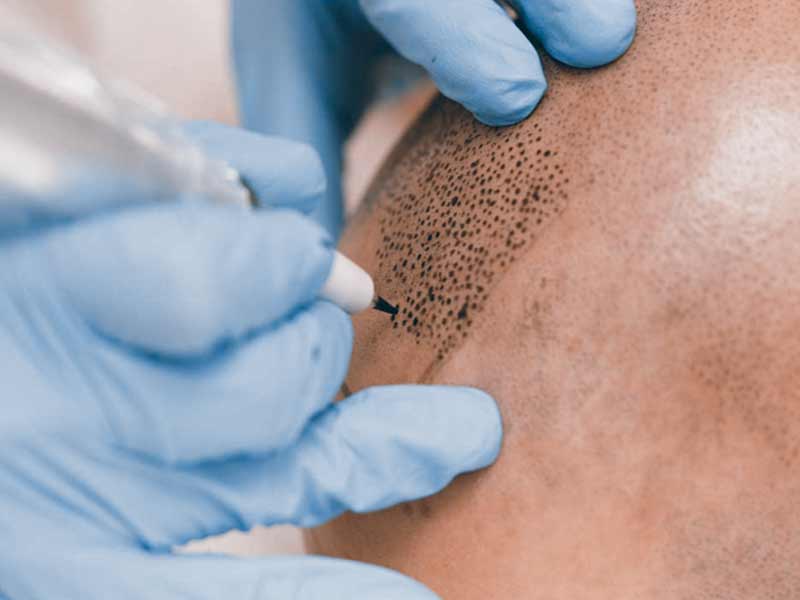What is tricopigmentation ?

Tricopigmentation: For most people suffering from alopecia or loss of hair density, hair transplantation is the best solution. However, it may happen that a patient is not a candidate for hair transplantation, for several reasons: donor area of too low density, alopecia at too advanced a stage, patient suffering from a disease contraindicating the hair restoration operation… For these people, of course, other solutions can be offered to them, and in particular tricopigmentation.
What is it ?

This treatment is a method of scalp micropigmentation to simulate hair follicles, reducing the contrast between the color of the hair and that of the balding scalp. Thanks to a specific machine to introduce pigments into the epidermis, this technique is non-invasive and painless, and allows both men and women to remedy their hair loss problem.
The different types:
There are several types of tricopigmentation:
- Temporary tricopigmentation: which requires maintenance sessions once or twice a year. This technique allows the result to fade over time, in the event of a change of opinion of the patient.
- Permanent tricopigmentation: this treatment does not fade over time. Maintenance sessions will also be necessary, but only every 4 to 5 years. If you wish to change your look, laser sessions will be necessary to erase the results of permanent tricopigmentation.
For different effects:
- Shaved head effect: allows you to reconstruct a shaved head effect, on a person suffering from alopecia or even total baldness.
- More density effect: allows you to create coverage in the case of long hair.
- Camouflage of scars: after a hair transplant with the FUT method, or on accidental scars.
Is this process effective?
Thanks to the improvement of this technique over the years, we can say that yes, tricopigmentation is a rather effective treatment. However, this technique has nothing to do with a hair transplant, so do not expect the same results.
While after a hair transplant, the implanted hair will grow and become denser naturally, after having carried out this treatment, the patient will simply have a trompe l’oeil result.
Hair transplant and tricopigmentation
After a hair transplant, tricopigmentation can come in addition. It is possible to perform it after a period of 6 months after a hair transplant.
It can help fill implanted areas that still lack density, or even give an impression of density on the donor area if it has been too thin during the transplant. Also, after a hair transplant with the FUT technique, which leaves a large scar on the back of the head, tricopigmentation can camouflage this often unsightly scar.
Difference between tattoo and tricopigmentation
The main difference is of course the device used. For temporary tricopigmentation, the pigments are injected less deeply than for a tattoo. Also, the chemical composition of the pigments used in tricopigmentation is different and the molecular structure is smaller. This allows the pigments to disappear over time.
When is it impossible to do this treatment?
In some cases, it is strongly advised not to perform tricopigmentation:
- On white hair.
- On blond or red hair.
- On an irritated scalp (Psoriasis or untreated dermatitis).
- On keloid scars.
- In case of autoimmune disease.
Where to do hair tricopigmentation sessions?
Get closer to a center specializing in tricopigmentation. Attention, the practitioner must have enough experience in the matter. As for a hair transplant, a preliminary diagnosis must be provided to you in order to define the areas to be treated, and thus a price can be given to you. Of course, the larger the area to be treated, the higher the price will be.
How much a session cost?
For partial coverage it will be necessary to count between 500€ and 1500€ per session.
For greater coverage, the price will be between €2,000 and €3,000 per session.
Of course, these prices may vary from one center to another.

Dr. Baykal Oymak is a highly esteemed transplant specialist hailing from Turkey, boasting an impressive 17-year tenure in the medical field. His professional journey commenced as a dermatologist at Bogazici Hospital in Istanbul, where he began to hone his expertise. Since then, Dr. Oymak has conducted a remarkable tally of approximately 14,000 triumphant hair transplant procedures within Turkey. Additionally, he holds specialization in PRP treatment and Mesotherapy, further solidifying his reputation as a versatile and accomplished practitioner in the realm of dermatology and transplantation. » SCHEDULE YOUR HAIR TRANSPLANT IN TURKEY HERE «
